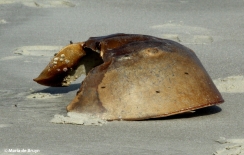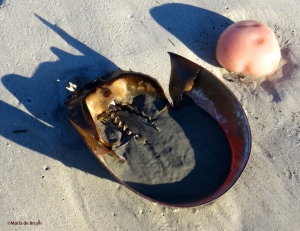Many people in the USA, especially but not only in the South, grow up knowing what crawdads (Cambarus bartoni) are. This was not the case for me. My immigrant family pretty much stuck to the dietary customs of their own and their friends’ home countries (The Netherlands, Belgium, Germany). Like pumpkin pie, sweet potatoes and okra, crawdads were not on those menus and so it was only recently that I actually learned that these crustaceans are the same thing as crayfish, of which I had heard as a child.
This year was my time to learn more about these members of the arthropod family who are related to lobsters – it turned out they were thriving in a pond created through a man-made wetlands installed between a shopping mall and several apartment complexes. I learned about their presence when local birders alerted one another that the crawdads were attracting a family of yellow-crowned night herons (Nyctanassa violacea).
 Hoping to spot the herons, I also visited the wetlands and first noted the crayfish remains scattered around near the pond. Shortly thereafter, I came across one crossing a path in another local nature park (photos above and below). It was interesting to see how the crawdad first stayed stock still as I neared and then stood tall on its legs as its tail propelled it backwards while it made a dash for the nearby pond.
Hoping to spot the herons, I also visited the wetlands and first noted the crayfish remains scattered around near the pond. Shortly thereafter, I came across one crossing a path in another local nature park (photos above and below). It was interesting to see how the crawdad first stayed stock still as I neared and then stood tall on its legs as its tail propelled it backwards while it made a dash for the nearby pond.
The crawdad females lay hundreds of eggs; scientists do not yet know how long they incubate before birth but estimate it takes somewhat longer than a month before they hatch. In North Carolina, there are almost 50 species of these animals and several species are found only in this state.
The crayfish at the wetlands must have had a successful year because the place became a real buffet for various birds. Both adult and young night herons stayed near this pond for quite a long time before leaving to migrate to more southerly climes for the winter.
The adult herons were attractive with their boldly patterned heads.
They kept up their looks through regular preening.
Sometimes, they emerged from the pond weeds to perch on a snag while peering into the water on the lookout for a meal.
It was interesting to learn that while the adults have yellow legs most of the year, their legs can turn red or pink during breeding season.
In my experience, the younger herons were a bit less shy and didn’t fly off so quickly when I neared.
One in particular decided to take the sun in mid-August, adopting a pose that I more often see taken by great blue herons and which I’ve nicknamed the “flasher stance.”
The young birds, like their parents, stalked the pond vegetation on the lookout for crawdad snacks.
They also showed the herons’ taste for other food such as snails, earthworms and insects.
The night herons, for which most birders visited the wetlands, weren’t the only birds at the buffet, however. Red-shouldered hawks (Buteo lineatus) also showed a fondness for the crustaceans.
The herons weren’t always alert to their presence. One adult, for example, decide to fly to a low perch when chased away from a tall snag by a hawk. S/he settled in for a bit of preening but was then rudely chased off by the same hawk. (That hawk was later harassed by a group of crows, who chased it away in turn.)
Other herons who were interested in outdoor crayfish dining during the humans’ Covid epidemic, included the great blue herons (Ardea herodias).
Green herons (Butorides virescens) visited the pond regularly as well, eating small fish in addition to the other wetland delicacies.
Belted kingfishers (Megaceryle alcyon) were busy flying to and fro over the length of the pond, but I didn’t see them carry off any crayfish so they must have been focused on fish.
 A great egret (Ardea alba) was a regular visitor, too, stalking different areas of the pond.
A great egret (Ardea alba) was a regular visitor, too, stalking different areas of the pond.
The adult night herons obviously thought it was interesting to watch the egret’s foraging technique.
Other regular visitors to the wetlands included a flock of Canada geese, American and fish crows, Northern mockingbirds and wandering glider dragonflies (Pantala flavescens).
There were so many animals feeding on the crawdads this summer that the female crayfish must have had a lot of success with their offspring reaching maturity. The last reported sighting of the yellow-crowned night herons at the wetland was 24 October, but I’m guessing that they will be leaving soon and the pond will not be so busy this autumn. The crayfish population had to have been reduced mightily over the summer season, so it will be interesting to see whether it rebounds and attracts crowds of birds — and birders — next year!























































































































 When a butterfly like the cabbage white (Pieris rapae) alights on a flower or leaf, we sometimes have a little time to see them more clearly and appreciate their beauty; capturing a photo for leisurely viewing gives us the chance to focus on details. And those details are important if we want to determine their correct scientific names since entomologists have differentiated many species and sub-species, sometimes on the basis of factors such as the shape of their spots.
When a butterfly like the cabbage white (Pieris rapae) alights on a flower or leaf, we sometimes have a little time to see them more clearly and appreciate their beauty; capturing a photo for leisurely viewing gives us the chance to focus on details. And those details are important if we want to determine their correct scientific names since entomologists have differentiated many species and sub-species, sometimes on the basis of factors such as the shape of their spots.
















 The hackberry emperor (Asterocampa celtis) turned up at Jordan Lake, while the common buckeye (Junonia coenia) – whose beauty is anything but common! – was in my yard and various nature reserves. I also observed a pair getting ready to propagate the next generation.
The hackberry emperor (Asterocampa celtis) turned up at Jordan Lake, while the common buckeye (Junonia coenia) – whose beauty is anything but common! – was in my yard and various nature reserves. I also observed a pair getting ready to propagate the next generation.









 It is now early December and late autumn in the Northern hemisphere, so why a blog about butterflies? When I was writing this on the last day of November, I had still seen a few of these beauties a couple days previously, and in the Southern hemisphere it is late spring, so it seems fine as a topic for a nature blog. Also, three weeks ago, my mother passed away, while in two weeks the anniversary of my father’s death comes again — I like to think of butterflies as nature’s emissaries for spirits on the wing. They allow me to think of my parents in somewhat lighter terms than the sadness that predominated during their dying processes. Because there are so many butterflies to highlight, this will be a two-part blog.
It is now early December and late autumn in the Northern hemisphere, so why a blog about butterflies? When I was writing this on the last day of November, I had still seen a few of these beauties a couple days previously, and in the Southern hemisphere it is late spring, so it seems fine as a topic for a nature blog. Also, three weeks ago, my mother passed away, while in two weeks the anniversary of my father’s death comes again — I like to think of butterflies as nature’s emissaries for spirits on the wing. They allow me to think of my parents in somewhat lighter terms than the sadness that predominated during their dying processes. Because there are so many butterflies to highlight, this will be a two-part blog.

 The juniper hairstreak (Callophrys gryneus) was another new visitor that at first made me think it was covered in pollen.
The juniper hairstreak (Callophrys gryneus) was another new visitor that at first made me think it was covered in pollen.

































